Fifth year medical students’ education, confidence and learning needs related to healthcare provision for sexual and gender minority patients: a cross-sectional survey
Rona Carroll 1 * , Sally B. Rose
1 * , Sally B. Rose  1 , Susan M. Garrett 1 , Lesley Gray
1 , Susan M. Garrett 1 , Lesley Gray  1
1
1 Department of Primary Health Care and General Practice, University of Otago, Wellington, PO Box 7343, Wellington South 6242, New Zealand.
Journal of Primary Health Care 15(2) 122-127 https://doi.org/10.1071/HC22082
Published: 21 December 2022
© 2022 The Author(s) (or their employer(s)). Published by CSIRO Publishing on behalf of The Royal New Zealand College of General Practitioners. This is an open access article distributed under the Creative Commons Attribution-NonCommercial-NoDerivatives 4.0 International License (CC BY-NC-ND)
Abstract
Introduction: Education on health care for patients with diverse sexual orientation, sex characteristics and gender identities is lacking in Aotearoa’s medical schools.
Aim: This study surveyed fifth-year medical students at the University of Otago Wellington (UOW) about confidence in providing health care to lesbian, gay, bisexual, transgender, queer, intersex and asexual (LGBTQIA+) patients to identify learning needs.
Methods: This anonymous cross-sectional survey was designed with input from an advisory group (community members, education, research and subject matter experts). It was administered on paper during class, using Likert scales (level of agreement) and open-ended questions. All fifth-year medical students at the UOW campus were invited to participate in May 2021. Data were analysed in Microsoft Excel (Microsoft Corporation) and free-text comments were analysed using template analysis.
Results: In total, 74.7% (71/95) of students completed a survey. Participants lacked knowledge and confidence in their consultation skills with LGBTQIA+ patients and did not feel they had enough teaching in this area. Most (≥78.8%) were comfortable with common terms, but half or fewer could explain intersex, gender affirmation and Takatāpui. Free-text comments revealed learning needs relating to consultation skills, ways to approach this topic with sensitivity, and a desire to learn more about the cultural context.
Discussion: Medical students view LGBTQIA+ health care as an important topic and want opportunities to improve knowledge and confidence in this area. Students lack confidence in consulting with LGBTQIA+ patients, suggesting that more education focused on practical experience and interactions with real patients would be of benefit.
Keywords: communication skills, healthcare, LGBTQIA+, medical education, medical education research, primary care, survey, undergraduate.
| WHAT GAP THIS FILLS |
| What is already known: LGBTQIA+ patients face barriers accessing appropriate health care. Education on health care for patients with diverse sexual orientation, sex characteristics and gender identities is lacking in Aotearoa’s medical schools. |
| What this study adds: Medical students view teaching on LGBTQIA+ health care as important, but feel education is lacking. They want to feel more comfortable in their consultation skills with LGBTQIA+ patients, they lack confidence in their knowledge of transgender health care, and worry about inadvertently causing offence. |
Introduction
Discrimination and lack of healthcare provider knowledge related to lesbian, gay, bisexual, transgender, queer, intersex and asexual (LGBTQIA+) health care contribute to reduced help seeking and poorer physical and mental health outcomes compared with the general population.1 Many do not access health care and feel uncomfortable discussing gender identity with their general practitioner (GP).2 When a young person feels comfortable discussing their gender identity and health needs with their GP, there is a positive correlation with their general and mental health.3
Implementation of sexuality and gender teaching into the undergraduate medical curriculum can increase student knowledge, awareness, and comfort with providing care.4,5 In Aotearoa, medical schools deliver limited content relating to LGBTQIA+ health care,6 and it mostly focuses on sexuality rather than gender.7 Medical doctors must be equipped with the communication skills and knowledge to meet the needs of LGBTQIA+ patients and to create consultation environments where patients feel welcome and safe to talk openly.
Medical students at the University of Otago spend the first 3 years of their program in Dunedin, then in one of three campuses across Aotearoa for their advanced learning years. We surveyed fifth-year students at the University of Otago Wellington (UOW) campus to identify their learning needs in relation to LGBTQIA+ health care.
Methods
Participants and recruitment
All UOW campus fifth-year students (n = 95) were invited to complete an anonymous survey in May 2021 during class. Those who were absent were subsequently emailed an invitation to complete the survey online. This study was approved by the University of Otago Human Ethics Committee (Ref: D20/443, 22 December 2020).
Survey design and development
The brief cross-sectional survey was designed to explore students’ knowledge of common LGBTQIA+ terminology, level of confidence in consulting with LGBTQIA+ patients, and previous experiences of medical education on this topic. Four open-ended questions invited free-text comments on LGBTQIA+ education and healthcare experiences (see survey in Supplementary File S1). Input into the survey was sought from an advisory group that included academics and health professionals representing the LGBTQIA+ community, subject matter experts and education expertise. A fifth-year medical student pre-tested the survey and provided feedback that was incorporated into the final version.
Analysis
Survey data were entered into the QualtricsXM online survey platform (Qualtrics International Inc) then exported into Microsoft Excel (Microsoft Corporation) for collation and analysis. Ethnicity data were re-coded to report prioritised ethnicity for people reporting more than one ethnic group.8 Response frequencies were tabulated (number, percentage) for all survey items. Free-text comments (186 responses were provided to four open-ended questions) were analysed using template analysis,9 with initial coding undertaken by RC for individual questions, which were subsequently combined into one set of themes (agreed upon by all authors).
Results
The survey was completed by 71 fifth-year medical students (74.7%, 71/95). The demographic characteristics of participants are shown in Table 1.
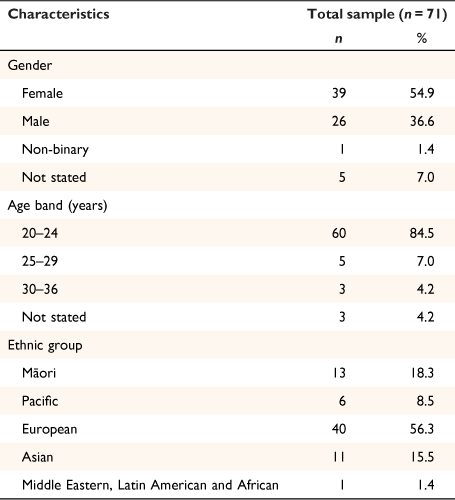
|
Knowledge of terminology
Fig. 1 presents students’ level of agreement with statements asking about knowledge of LGBTQIA+ terminology. There was a reasonably high level of comfort in feeling able to explain common terms, with over 78.8% agreeing they could explain six out of nine commonly used terms to a fellow medical student. The term with the lowest level of understanding was ‘Takatāpui’ (a Māori term meaning ‘intimate companion of the same sex.’ It has been reclaimed as an umbrella term to embrace all Māori who identify with diverse sexes, genders and sexualities),10 which only 25.4% felt they could explain to a fellow student.
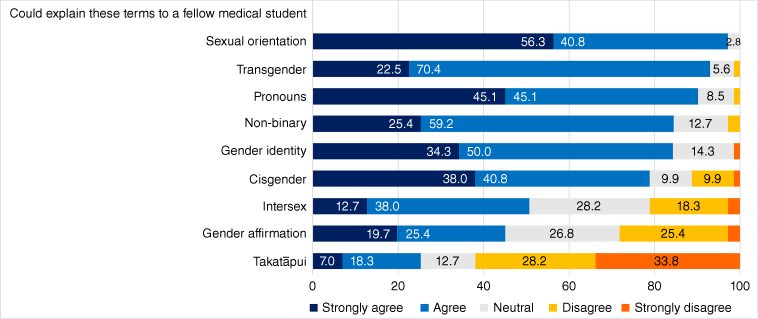
|
Confidence consulting with LGBTQIA+ patients
The percentage of participants agreeing with statements about their confidence consulting with LGBTQIA+ patients are shown in Fig. 2. The majority (90.1%) of participants felt confident in consulting with patients in general (i.e. NOT specific to LGBTQIA+ patients). Confidence was lower for all topics related to consultation with LGBTQIA+ patients. When it came to consulting with transgender patients on gender identity issues, 39.5% felt confident with this, and only one-quarter (25.7%) felt confident to consult on issues relating to being intersex.
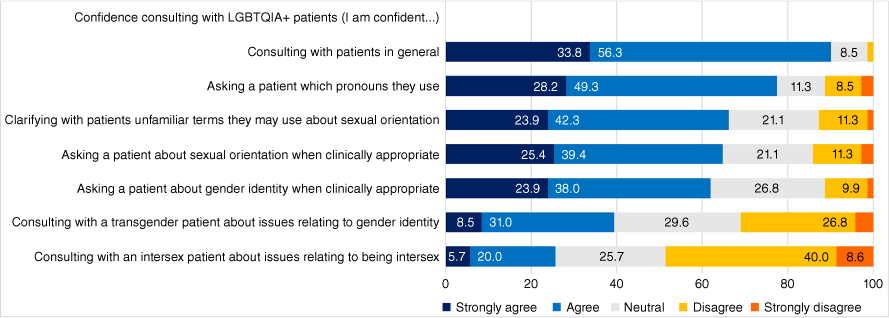
|
Education received about LGBTQIA+ healthcare
Fig. 3 presents percentages of participants agreeing with statements about LGBTQIA+ healthcare education received at medical school. Almost all students (94.4%) agreed that teaching about LGBTQIA+ health care is important in medical school, but most students did not feel that they had received enough teaching about this area of health care. Two-thirds of the group (65.2%) reported that most of their education on this topic was from outside of medical school.
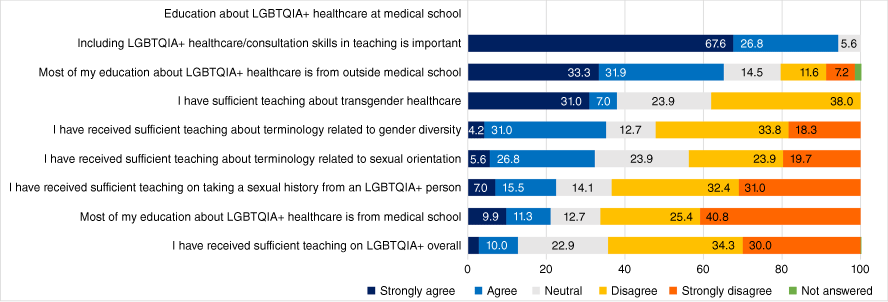
|
Participant comments about learning gaps and areas identified for future learning
Table 2 presents a summary of themes identified from comments about aspects that healthcare students feel least confident about, and areas identified for future learning (with illustrative quotes). Regarding medical school education about caring for LGBTQIA+ patients, 26 participants noted that they had ‘very little’, ‘not enough’ or that this education was ‘non-existent’. Several participants provided positive comments about specific teaching sessions that they had found useful. Others stated that opportunities to learn in the context of actual patients from the LGBTQIA+ community were limited, but would be valuable.
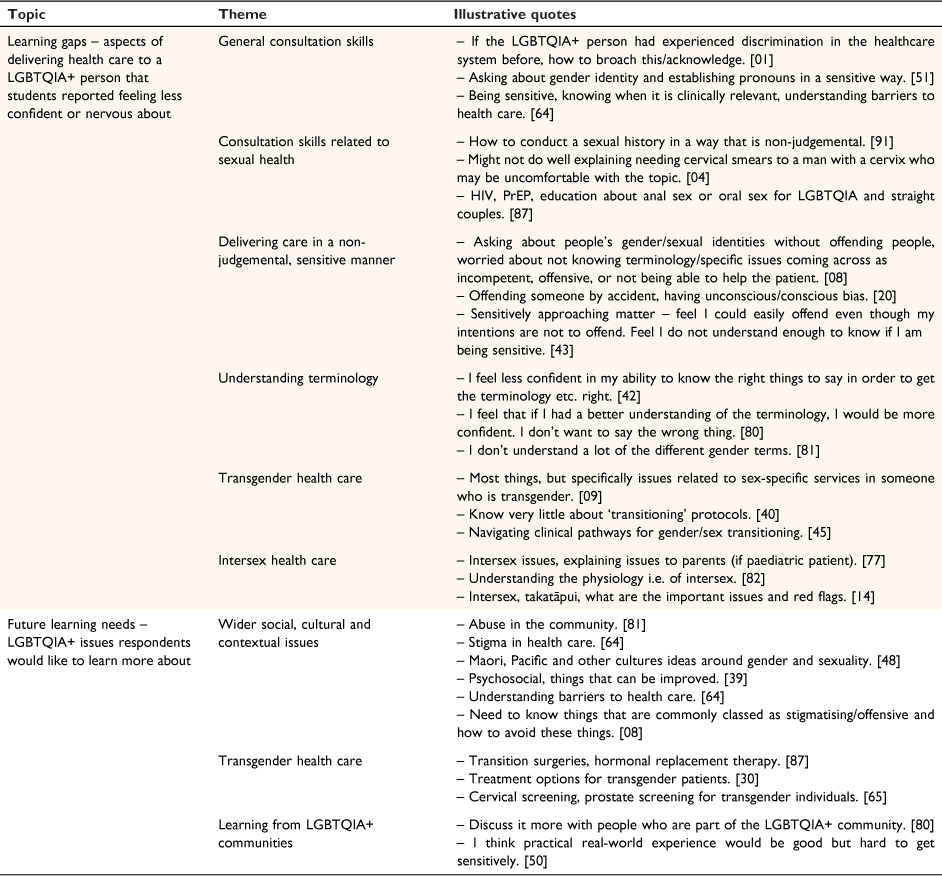
|
Discussion
Our results show that UOW fifth-year medical students lack confidence in consulting with LGBTQIA+ patients, and this is particularly evident in areas relating to transgender and intersex health care. Their lack of confidence in these specific areas related to a perceived lack of teaching, resulting in a lower level of knowledge about transgender and intersex health. Participants reported lack of confidence in consultations did not necessarily relate to clinical knowledge level, but instead to ways of forming trusting relationships and engaging with patients. Students were keen to do the right thing and provide optimal care, but feared they would say the wrong thing or appear judgemental.
These findings suggest students have similar levels of confidence in asking patients about sexual orientation or gender identity (around two-thirds in agreement), but very few students felt they had enough overall teaching on LGBTQIA+ health. This finding differs from some overseas surveys – a UK survey of 252 medical students found that confidence in discussing sexuality increased with each year of study, but confidence in discussing gender identity did not.11
Two sessions in the UOW fifth-year curriculum that aim to teach students about diversity of gender, sexuality and sex characteristics were specifically mentioned as positive learning experiences by survey participants. One of these, a session taught by a health professional who is also an LGBTQIA+ community member, gives students the opportunity to go through case studies12 and consider their own implicit bias, and the other is focused on consultations with simulated patients.13 Given students reported lack of confidence, knowledge and education in this area, it is likely that a greater number of opportunities for practical and clinical exposure would be valued.
One reason for lower levels of confidence can be a perceived complexity with LGBTQIA+ patients compared to heterosexual and cisgender patients, and a fear of causing unintentional offense. Addressing any preconceived judgements, by providing practical experience with patients, could improve medical student confidence and begin to address unconscious bias.14 Studies in the US found that higher exposure to LGBTQIA+ patient contacts related to higher levels of preparedness and knowledge,15 and saw positive changes in knowledge and attitudes among medical students who took part in a panel session with LGBTQIA+ community members.4
Our survey findings highlight a clear need for more teaching in this area. One way to address lack of staff subject matter expertise is to include community members in teaching to build on the knowledge and strengths both can bring to the classroom.16,17 In doing so, it is essential to include cultural diversity, as our results show that understanding of Māori terms relating to diversity of sexual orientation and gender identity is lacking.
Strengths and limitations
This is one of the first surveys of LGBTQIA+ education and student confidence to be undertaken in a NZ medical school. The response rate was good, and the majority of participants provided free-text comments, which expanded on and helped to provide context around some of the forced choice questions. Over a quarter of the students who completed the survey were of either Māori or Pacific ethnicity. Although we asked about knowledge of Māori terminology, we did not ask about Pacific cultural terms (but acknowledge this also needs to be included in NZ medical education). Some questions about gender identity did not have an equivalent question about sexual orientation, making it hard to draw comparisons in some areas. A limitation of the survey sample is that it included only one of the three campuses providing teaching to fifth-year students, so the experience described by this group might not reflect teaching and learning needs across the entire medical school.
Conclusions
Fifth-year medical students lack confidence in consulting with LGBTQIA+ patients and feel that education is lacking in medical school. To address areas of low confidence and potential student unconscious bias, medical schools should consider including teaching sessions with a focus on LGBTQIA+ consultation skills, and more exposure to sexual and gender minority patients.
Supplementary material
Supplementary material is available online.
Data availability
The data that support this study cannot be publicly shared due to ethical or privacy reasons and may be shared upon reasonable request to the corresponding author, if appropriate.
Conflicts of interest
The authors report there are no competing interests to declare.
Declaration of funding
This work was funded by a University Teaching Development Grant awarded by the University of Otago Committee for the Advancement of Learning and Teaching (2021).
Acknowledgements
The authors would like to thank the project advisory group and participating medical students for taking the time to complete a survey and sharing their views with us.
References
[1] New Zealand Human Rights Commission. Prism: Human rights issues relating to Sexual Orientation, Gender Identity and Expression, and sex characteristics (SOGIESC) in Aotearoa New Zealand. Wellington, New Zealand: Human Rights Commission; 2020.[2] Tan KKH, Ellis SJ, Schmidt JM, et al. Mental health inequities among transgender people in Aotearoa New Zealand: findings from the Counting Ourselves Survey. Int J Environ Res Public Health 2020; 17 2862
| Mental health inequities among transgender people in Aotearoa New Zealand: findings from the Counting Ourselves Survey.Crossref | GoogleScholarGoogle Scholar |
[3] Clark BA, Veale JF, Greyson D, et al. Primary care access and foregone care: a survey of transgender adolescents and young adults. Fam Pract 2018; 35 302–6.
| Primary care access and foregone care: a survey of transgender adolescents and young adults.Crossref | GoogleScholarGoogle Scholar |
[4] Kelley L, Chou CL, Dibble SL, et al. A critical intervention in lesbian, gay, bisexual, and transgender health: knowledge and attitude outcomes among second-year medical students. Teach Learn Med 2008; 20 248–53.
| A critical intervention in lesbian, gay, bisexual, and transgender health: knowledge and attitude outcomes among second-year medical students.Crossref | GoogleScholarGoogle Scholar |
[5] Safer JD, Pearce EN. A simple curriculum content change increased medical student comfort with transgender medicine. Endocr Pract 2013; 19 633–7.
| A simple curriculum content change increased medical student comfort with transgender medicine.Crossref | GoogleScholarGoogle Scholar |
[6] Taylor O, Rapsey CM, Treharne GJ. Sexuality and gender identity teaching within preclinical medical training in New Zealand: content, attitudes and barriers. N Z Med J 2018; 131 35–44.
[7] Sanchez AA, Southgate E, Rogers G, et al. Inclusion of lesbian, gay, bisexual, transgender, queer, and intersex health in Australian and New Zealand medical education. LGBT Health 2017; 4 295–303.
| Inclusion of lesbian, gay, bisexual, transgender, queer, and intersex health in Australian and New Zealand medical education.Crossref | GoogleScholarGoogle Scholar |
[8] Ministry of Health. HISO 10001:2017 Ethnicity Data Protocols. Wellington: Ministry of Health; 2017. Available at https://www.health.govt.nz/publication/hiso-100012017-ethnicity-data-protocols [Accessed 12 March 2021].
[9] King N. Doing template analysis. In: Symon G, Cassell C, editors. Qualitative organizational research: core methods and current challenges. Vol. 426. SAGE Publications, Inc.; 2012. pp. 77–101.
| Crossref |
[10] Kerekere E. Takatāpui: Part of the Whānau, 2nd edn. Auckland: Tiwhanawhana Trust and Mental Health Foundation; 2016.
[11] Arthur S, Jamieson A, Cross H, et al. Medical students’ awareness of health issues, attitudes, and confidence about caring for lesbian, gay, bisexual and transgender patients: a cross-sectional survey. BMC Med Educ 2021; 21 1–8.
| Medical students’ awareness of health issues, attitudes, and confidence about caring for lesbian, gay, bisexual and transgender patients: a cross-sectional survey.Crossref | GoogleScholarGoogle Scholar |
[12] Carroll R, Gray L. Diversifying clinical education case studies. Clin Teach 2021; 18 494–6.
| Diversifying clinical education case studies.Crossref | GoogleScholarGoogle Scholar |
[13] Canty J, McBain L, Gray L. Simulating ‘that jaw drop moment’: challenging heteronormative assumptions in a novel clinical consultation skills session with undergraduate medical students. MedEdPublish 2021; 10
| Simulating ‘that jaw drop moment’: challenging heteronormative assumptions in a novel clinical consultation skills session with undergraduate medical students.Crossref | GoogleScholarGoogle Scholar |
[14] Bunting SR, Calabrese SK, Spigner ST, et al. Evaluating medical students’ views of the complexity of sexual minority patients and implications for care. LGBT Health 2022; 9 348–58.
| Evaluating medical students’ views of the complexity of sexual minority patients and implications for care.Crossref | GoogleScholarGoogle Scholar |
[15] Nowaskie DZ, Patel AU. How much is needed? Patient exposure and curricular education on medical students’ LGBT cultural competency. BMC Med Educ 2020; 20 1–8.
| How much is needed? Patient exposure and curricular education on medical students’ LGBT cultural competency.Crossref | GoogleScholarGoogle Scholar |
[16] Treharne GJ, Blakey AG, Graham K, et al. Perspectives on expertise in teaching about transgender healthcare: a focus group study with health professional programme teaching staff and transgender community members. Int J Transgend Health 2021; 23 1–27.
| Perspectives on expertise in teaching about transgender healthcare: a focus group study with health professional programme teaching staff and transgender community members.Crossref | GoogleScholarGoogle Scholar |
[17] Hayward M, Treharne GJ. Clinical psychology students’ perspectives on involving transgender community members in teaching activities within their training in Aotearoa New Zealand. Psychol Sex Orientat Gend Divers 2022; 9 309–20.
| Clinical psychology students’ perspectives on involving transgender community members in teaching activities within their training in Aotearoa New Zealand.Crossref | GoogleScholarGoogle Scholar |


